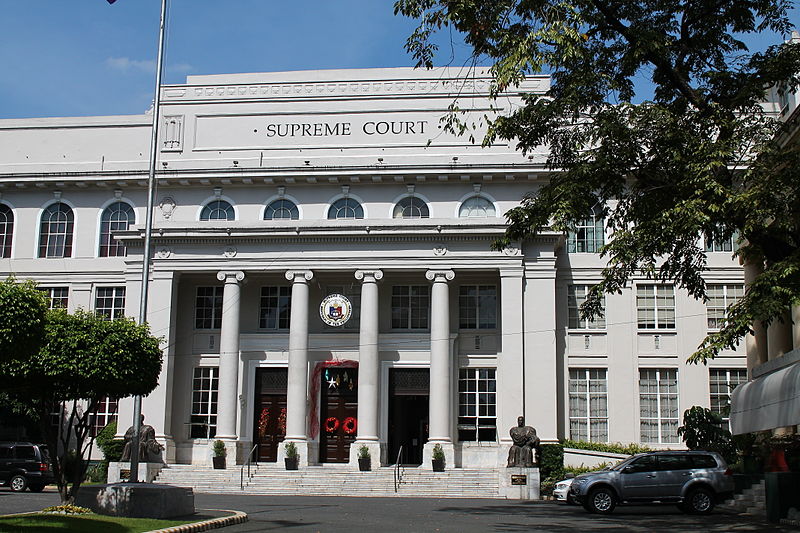News
SC reminds anew compliance with rules in drug busts

This, after the High Court acquitted a man convicted for the sale of less than a gram of shabu, due to the failure of police officers who arrested him to comply with Section 21 of RA 9165, or the Comprehensive Dangerous Drugs Act of 2002, ensuring the chain of custody in confiscated, seized, and/or surrendered dangerous drugs in drug-related cases. (File Photo By Aerous – Own work, CC BY-SA 3.0)
MANILA — The Supreme Court (SC) has stressed strict adherence to the law ensuring the chain of custody of evidence in drug-related cases.
This, after the High Court acquitted a man convicted for the sale of less than a gram of shabu, due to the failure of police officers who arrested him to comply with Section 21 of RA 9165, or the Comprehensive Dangerous Drugs Act of 2002, ensuring the chain of custody in confiscated, seized, and/or surrendered dangerous drugs in drug-related cases.
In a 15-page decision dated Nov. 5 penned by Associate Justice Diosdado M.
Peralta, the Court’s Third Division reversed and set aside the Nov. 16, 2016 decision of the Court of Appeals convicting accused-appellant Federico Señeres, Jr. for violation of Article II, Section 5 of RA 9165.
Señeres and co-accused Federico Valencia Jr. were apprehended during a drug buy-bust at the food court of the Market!Market! Mall in Taguig on Sept. 14, 2011.
Señeres insists there was a gap in the chain of custody of the seized items. He claimed that he and Valencia were seated and talking to each other when they were accosted by two armed men. Valencia died while the case was being tried and the charges against him were dismissed pursuant to Article 89 of the Revised Penal Code.
Señeres was ordered released from detention unless he is confined for any other lawful cause.
“There being no justifiable reason in this case for the non-compliance of Section 21 of R.A. No. 9165, this Court finds it necessary to acquit the appellant for failure of the prosecution to prove his guilt beyond reasonable doubt,” the Court ruled.
The court noted that under the original provisions of RA 9165, after seizure and confiscation of the drugs, the apprehending team is required to immediately conduct a physical inventory and photograph the same in the presence of (1) the accused or the person/s from whom such items were confiscated and/or seized, or his/her representative or counsel; (2) a representative from the media and (3) from the Department of Justice (DOJ); and (4) any elected public official who shall be required to sign the copies of the inventory and be given a copy thereof.
There were no representatives from the media and the DOJ, and there was no elected public official present during the physical inventory and photographing of the seized items, the court noted.
A security guard of the mall witnessed the said inventory. An explanation on the absence of the required witnesses is also not provided nor was there any evidence to prove that the police officers exerted any effort to seek their presence, the court pointed out.
The Court stressed that “[a] stricter adherence to Section 21 of R.A. No. 9165 is required where the quantity of illegal drugs seized is miniscule since it is highly susceptible to planting, tampering, or alteration.”
The Court noted that the in the present case, the old provisions of Section 21 of RA No. 9165 and its Implementing Rules and Regulations shall apply since the alleged crime was committed before the amendment in 2014 under R.A. No.10640 .
Under the said amendment, “the conduct of physical inventory and photograph of seized items must be in the presence of (1) the accused or the person/s from whom such items were confiscated and/or seized, or his/her representative or counsel; (2) an elected public official; and (3) a representative of the National Prosecution Service or the media who shall sign the copies of the inventory and be given a copy thereof.”
The Court also mentioned its Sept. 4, 2013 decision in People v. Lim (GR No. 231980), where it laid down the following guideline, which is prospective in nature, that must now be followed in order that the provisions of Sec. 21 of RA 9165 must be well-enforced and duly proven in courts.
Under the said ruling in the sworn statements/affidavits, the apprehending/seizing officers must state their compliance with the requirements of Section 21 (1) of RA 9165, as amended, and its Implementing Rules and Regulations;
In case of non-observance of the provision, the apprehending/seizing officers must state the justification or explanation therefor as well as the steps they have taken in order to preserve the integrity and evidentiary value of the seized/confiscated items;
If there is no justification or explanation expressly declared in the sworn statements/affidavits, the investigating fiscal must not immediately file the case before the court. Instead, he or she must refer the case for further preliminary investigation in order to determine the (non) existence of probable cause; and
Finally under the Lim ruling, if the investigating fiscal filed the case despite such absence, the court may exercise its discretion to either refuse to issue a commitment order (or warrant of arrest) or dismiss the case outright for lack of probable cause in accordance with Section 5, Rule 112, Rules of Court.





















